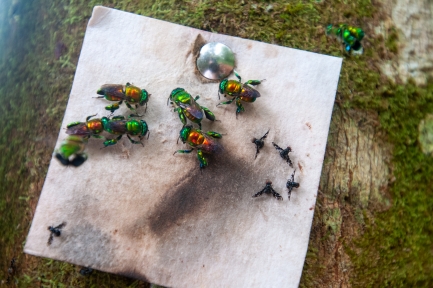Orchid Bees Show Remarkable Resistance to Major Climate Events
In the tropical forest of Barro Colorado Island, Panama, metallic blue, green, gold and red bees follow the fragrances of flowering orchids. Male euglossines, or orchid bees, are wild New World bees attracted to the strong scents produced by flowers, fungi and fruit in nature. These pollinators’ populations, and their response to major climatological events, are the focus of long-term studies by David Roubik and Yves Basset, both staff scientists at the Smithsonian Tropical Research Institute (STRI).
After 40 years of monitoring and identifying 132,000 individual orchid bees in two protected lowland forest sites in Panama—the longest continuous study of bee populations of its kind—Roubik and colleagues discovered that most species were not affected by major climate events such as El Niño or La Niña phenomena. On the contrary, the majority were either stable or increasing over time. Their findings were recently published in the journal Conservation Science and Practice.
These bees make life easy for researchers: They can be lured to chemical baits—like wintergreen oil, cinnamon oil and even skatole (the main contributor to fecal odor)—placed in the forest. They have no stinger and can be easily handled and identified to the species level. Roubik’s research on orchid bees builds on pioneering work by the late STRI botanist Robert Dressler, an orchid expert who developed a taxonomic key for bee identification that has been used since the 1960s.
Roubik’s own work in Panama began in 1979 when he joined STRI to address the need to predict the impact of Africanized honeybees on native bees as they spread from Brazil toward Central America. He never left Panama and continued to lead long-term studies.
“Over 70 bee generations were monitored during major climatic events, such as El Niño or La Niña, allowing our study to assess changes in survival or reproduction during such conditions,” Roubik said.
Bee populations also appeared to be more stable in older forests, perhaps due to increased protection from climate events and better access to an abundance of flowering trees and lianas (long-stemmed woody vines), an important resource for orchid bees. For the authors, these results confirm that tropical forests are naturally wise, protecting the pollinators that allow this particular ecological web of life to survive.
“As to whether wild bees are increasing, declining or maintaining their populations, and whether climate change is driving those populations in any particular direction, our study suggests great overall stability during decades,” Roubik said.
The Smithsonian Tropical Research Institute, headquartered in Panama City, Panama, is part of the Smithsonian Institution. The institute furthers the understanding of tropical nature and its importance to human welfare, trains students to conduct research in the tropics and promotes conservation by increasing public awareness of the beauty and importance of tropical ecosystems.
# # #
Roubik, D.W., Basset, Y., Lopez, Y., et al. (2021). Long-term (1979–2019) dynamics of protected orchid bees in Panama. Conservation Science and Practice, e543. https://doi.org/10.1111/csp2.543
SI-323-2021



